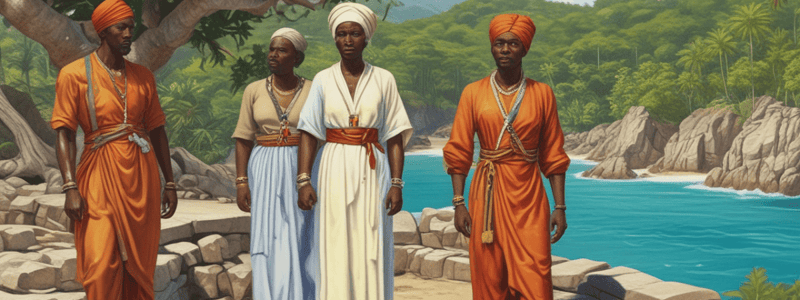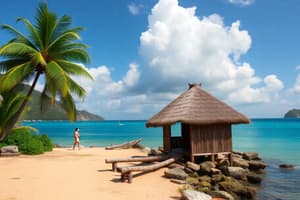Podcast
Questions and Answers
What was unique about the village of Long Look in the Virgin Islands?
What was unique about the village of Long Look in the Virgin Islands?
- It was a center for industrial production.
- It was a hub for international trade.
- It was established by European colonizers.
- It was a free village of Creole people surrounded by plantations. (correct)
Who granted the freed people the 50-acre cotton plantation, Long Look?
Who granted the freed people the 50-acre cotton plantation, Long Look?
- The British government.
- The local plantation owners.
- The Danish colonial authorities.
- The Quaker owners, Samuel and Mary Nottingham. (correct)
What was the main economic activity in Long Look after the abolition of slavery?
What was the main economic activity in Long Look after the abolition of slavery?
- Manufacturing and industry.
- Trade and commerce.
- Fishing and boatbuilding.
- Agriculture and livestock rearing. (correct)
What was the significance of cattle in Long Look's economy?
What was the significance of cattle in Long Look's economy?
What was the primary market for the surplus fish caught in Long Look?
What was the primary market for the surplus fish caught in Long Look?
What was the status of Long Look village during the era of enslavement?
What was the status of Long Look village during the era of enslavement?
How did the freed people acquire the 50-acre cotton plantation, Long Look?
How did the freed people acquire the 50-acre cotton plantation, Long Look?
What was the diversified economy of Long Look based on?
What was the diversified economy of Long Look based on?
Flashcards are hidden until you start studying
Study Notes
The Independent Free Village of Nottingham Estate
- In 1776, a group of 25 freed African men and women purchased their freedom from their masters, Samuel and Mary Nottingham, for £5.
- The Nottingham's, absentee Quaker owners, granted the freed people a 50-acre cotton plantation, Long Look, which Mary Nottingham had inherited from her father.
- The village of Long Look was established on the plantation, allowing the freed people to sustain themselves.
Unique Status of Long Look
- Long Look was a free village of Creole people surrounded by plantations until the abolition of slavery in 1834.
- The village emerged as a centre for farming, fishing, boatbuilding, and cattle-rearing.
- It also became a centre for families, artisans, and shipping entrepreneurs.
Economic System of Long Look
- The village had a diverse economic system with a variety of agricultural activities.
- Ground provisions were grown for consumption and surplus crops were sold.
- The village also provided pasture for large herds of livestock, particularly cattle.
- Cattle represented a liquid form of capital, easily converted to cash.
Fishing and Trading Activities
- Fishing pots, lines, and seines were used to produce a large amount of surplus fish.
- The surplus fish was corned and sold to nearby markets in St. Thomas.
- The village also engaged in trading activities with the Danish island of St. Croix.
Studying That Suits You
Use AI to generate personalized quizzes and flashcards to suit your learning preferences.




